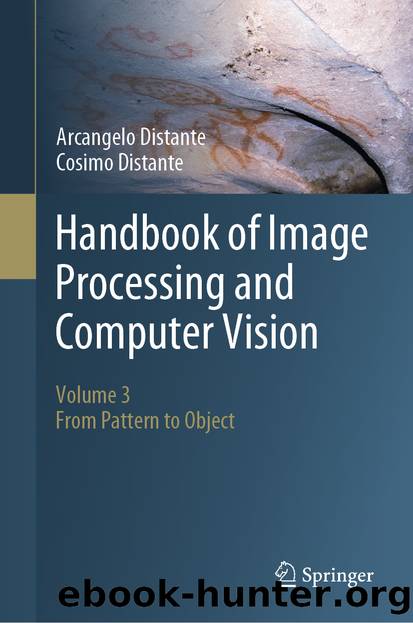Handbook of Image Processing and Computer Vision by Arcangelo Distante & Cosimo Distante

Author:Arcangelo Distante & Cosimo Distante
Language: eng
Format: epub
ISBN: 9783030423780
Publisher: Springer International Publishing
4.4.5 2.5D Sketch of Marr’s Theory
In Marr’s theory, the goal of the first stages of vision is to produce a description of the visible surface of the objects observed together with the information indicating the structure of the objects with respect to the observer’s reference system. In other words, all the information extracted from the visible surface is referred to the observer.
The primal sketch data are analyzed to perform the first level of reconstruction of the visible surface of the observed scene. These data (extracted as a bottom-up approach) together with the information provided by some modules of early vision, such as depth information (between scene and observer) and orientation of the visible surface (with respect to the observer) form the basis for the first 3D reconstruction of the scene. The result of this first reconstruction of the scene is called 2.5D Sketch, in the sense that the result obtained, generally orientation maps (called also needle map) and depth map, is something more than 2D information but it cannot be considered as a 3D reconstruction yet.
The contour, the texture, the depth, orientation and movement information (called by Marr information full primal sketch), extracted from the processes of early vision, such as stereo vision, movement analysis, analysis of texture and color, all together contribute to the production of 2.5D-sketch maps seen as intermediate information, temporarily stored, which give a partial solution waiting to be processed by the perceptual process, for the reconstruction of the visible surface observed.
Figure 4.25, shows an example of a 2.5D sketch map representing the visible surface of a cylindrical object in terms of orientation information (with respect to the observer) of elementary portions (patch) of the visible surface of the object. To render this representation effective, the orientation information is represented with oriented needles, whose inclination indicates how the patches are oriented with respect to the observer. These 2.5D sketch maps are called nedle map or orientation maps of the observed visible surface.
Fig. 4.252.5D sketch map derived from the full primal sketch map and from the orientation map. The latter adds the orientation information (with respect to the observer) for each point of the visible surface. The orientation of each element (patch) of visible surface is represented by a vector (seen as a little needle) whose length indicates how much it is inclined with respect to the observer (maximum length means the direction perpendicular to the observer, zero indicates pointing toward the observer), while the direction coincides with the normal at the patch
Download
This site does not store any files on its server. We only index and link to content provided by other sites. Please contact the content providers to delete copyright contents if any and email us, we'll remove relevant links or contents immediately.
| Computer Vision & Pattern Recognition | Expert Systems |
| Intelligence & Semantics | Machine Theory |
| Natural Language Processing | Neural Networks |
Algorithms of the Intelligent Web by Haralambos Marmanis;Dmitry Babenko(7880)
Hadoop in Practice by Alex Holmes(5674)
Jquery UI in Action : Master the concepts Of Jquery UI: A Step By Step Approach by ANMOL GOYAL(5528)
Life 3.0: Being Human in the Age of Artificial Intelligence by Tegmark Max(4539)
Functional Programming in JavaScript by Mantyla Dan(3733)
The Age of Surveillance Capitalism by Shoshana Zuboff(3445)
Big Data Analysis with Python by Ivan Marin(3186)
Blockchain Basics by Daniel Drescher(2909)
Test-Driven Development with Java by Alan Mellor(2732)
The Rosie Effect by Graeme Simsion(2731)
WordPress Plugin Development Cookbook by Yannick Lefebvre(2653)
Data Augmentation with Python by Duc Haba(2584)
Hands-On Machine Learning for Algorithmic Trading by Stefan Jansen(2570)
Applied Predictive Modeling by Max Kuhn & Kjell Johnson(2500)
Dawn of the New Everything by Jaron Lanier(2450)
Principles of Data Fabric by Sonia Mezzetta(2394)
The Infinite Retina by Robert Scoble Irena Cronin(2359)
The Art Of Deception by Kevin Mitnick(2314)
Rapid Viz: A New Method for the Rapid Visualization of Ideas by Kurt Hanks & Larry Belliston(2216)
